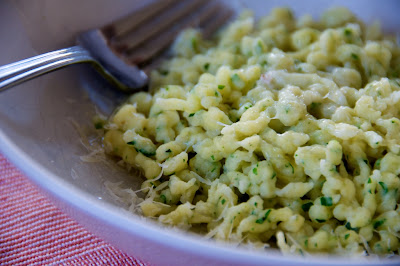SOMETIMES YOU don’t have the time or energy to devote to a well-executed ravioli, or even tagliolini. In our family we’ve been making a simple dish we call Polish Dumplings for years to satisfy the flour-and-egg yen. It’s quick, easy, and delicious in a hearty chicken or vegetable soup.
This same recipe can be repurposed without any extra effort to make something just that much more delicate and special. Spaetzle (also spelled spätzle) is really just a pile of tiny dumplings. There’s something about the mouth feel that’s addictive. Whereas dumplings are chunky and filling, spaetzle is light and tender.
Just about any occasion can call for spaetzle, even an afternoon of weeding in the yard. I pulled a couple of my favorites for the table: bittercress and dandelion greens. But I couldn’t find our cheap spaetzle maker so I resorted to a colander, and while you’ll see many recipes that suggest this method as an alternative, it’s really not the way you want to go. Buy an inexpensive spaetzle maker and you’ll make more spaetzle.
I used half the dough to make spaetzle and the rest for basic dumplings.
1 1/2 cups flour
1 tsp salt
2 eggs
1/2 cup milk
1/2 cup finely chopped weeds or herbs
parmesan at table
1. Put a pot of water on the boil. Whisk together eggs and milk in a small bowl.
2. Measure flour and salt into a large bowl, then add egg-milk mixture and chopped weeds and stir together with a fork until ingredients are mixed but not overly so. The dough should be sticky.
3. Salt boiling water generously. Press dough through spaetzle maker (or a colander, if you must) directly into boiling water.
For larger dumplings like these steaming on a plate (right), just pull gobs of dough off a fork and allow to fall directly into the pot. Both spaetzle and dumplings are ready when floating on the surface. It doesn’t take long.





My Swiss mother demands it be called Knopfli. I’ve never tried it with any greens, sounds delicious.
Your mother is right, but only partway. Spätzle tend to be a bit longer and are often made with a ricer. They are made with flour, eggs, water, and a pinch of salt. Knöpfle or Knöpfli are shorter and made with the spätzle makers and milk is usually substituted for the water.
The “origional” spätzle were made with neither a maker or ricer but with a cutting board and scraper. The batter is spread a bit at a time onto a small board and scraped in stripes to the edge where it drips into the pot of simmering water. I have tried this and it is a bit tricky but makes great spätzle once you get the knack!
Your “pull” dumplings are often done in Hungary and its environs. There are all sorts of local names for them, but they’re an awesome weeknight thing to do. Just make dough, let it rest an hour (or not) and toss bits into boiling water.
Bassist: Your description of Knopfli is exactly how I learned to make it. Although, my mom didn’t like her spaetzle maker and made it just using a fork to drip the dough into the water. It made the pieces a bit larger, and randomly shaped.
Hank:What’s the advantage of letting the dough rest for an hour?
Adamnfinetrout & Basic: I’m thinking mine is closer to Knopfli, in that case. As for the original way to make spaetzle, I think I’ll pass. Technology is good for some things.
Hank: There are few pasta-like foods as quick and foolproof as Polish (and Hungarian) dumplings. But man, the wee bit of extra effort to make spaetzle/knopfli/etc is sure worth it on some occasions.
This brings back memories of my mother making Polish (which she is) dumplings as well, but I wound up making hundreds of pounds of Spätzle at the Palace Kitchen in the first few years of that place.
We flavored them with thyme and used a full size hotel perforated pan and a bench scraper to boil them ahead of time. For service we browned them in clarified butter to serve with applewood roasted pork. Reading all of this makes me miss them.
this is a great comment section that I’m actually going to bookmark! need to get myself a spatzle maker.
The advantage of letting the Spätzle dough sit has to do with the flour used. Usually a couple of tablespoons of meal are added to give the spätzle more bite. If you don’t let the dough sit, it just ends up tasting like spätzle with sand.